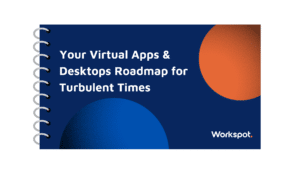Dan O’Farrell, Workspot VP of Product Marketing
The modern data center was created by VMware, with most organizations today running the majority of their workloads on a VMware stack. Now that Broadcom has acquired and retains the server and infrastructure parts of VMware, every organization is facing steep price increases for the most critical infrastructure software.
For organizations using VDI as their end user computing (EUC) solution, not only is there a shock based on Broadcom’s business strategy with the server virtualization infrastructure, but there is further shock based on the business strategy of the VDI market leader – Citrix, as well as for the Horizon VDI end user computing part of VMware that is now a new, separate company called Omnissa.
Most companies started deploying VDI in the mid-2010’s and we estimate that 95% of VDI users are deployed on on-premises infrastructure today. Given the long history of the issues created by VDI – boot storms, the noisy neighbor problem, performance of storage, volume of storage, de-duplication, pod architecture for every 2000 or so users, etc., many customers have called VDI “Very Difficult Infrastructure”. Many of these deployments have grown to accommodate tens of thousands of users and are now straining to satisfy the needs of both end-users and IT teams burdened by what is basically now decades old technology.
In spite of both unhappy end-users and over-burdened IT teams, organizations with firmly embedded VDI installations have been reluctant to make a radical decision to do something different. And this is understandable, given that VDI is such a difficult and labor-intensive workload to implement and operate. Why would anyone want to repeat that experience?
Most enterprise customers are evolving to deploy a hybrid multi-cloud strategy for their workloads. Depending on the use case, customers have three choices:
- On-premises: Deploy virtual apps & desktops on on-premises infrastructure
- On-premises + Any Cloud: Deploy one or more VDI use cases in the public cloud to take advantage of regional proximity
- On-premises + Multi-Cloud: Deploy in multiple clouds to optimize cost and/or availability
For VDI use cases, a hybrid multi-cloud strategy can deliver significant benefits by creating low-latency, high-performance user experiences, cost arbitrage, and high reliability via failover across clouds.
Workspot is a cloud-native unified digital workplace platform that supports web apps, virtual apps, and virtual desktops whether they are deployed on-premises, or on any cloud. Or both. Workspot also has a unified management and control console and an integrated, built-in observability suite that helps customers deliver higher productivity, availability, and security.
Given the current uncertainty across the VDI landscape and the shortcomings of traditional VDI solutions, many organizations are now looking at their options for the future with a sense of urgency.
Do you want to migrate just the app/desktop virtualization stack, just the server virtualization stack, or both? The cost of migration depends on each organization’s requirements, depreciation, negotiated discounts, and timing. The following questions are worth asking:
- Where are you in your enterprise architecture (EA) cycle with Broadcom? Citrix? Omnissa (Horizon)?
- Where are you in your depreciation cycle?
- Do you want to operate all aspects of your VDI moving forward?
- Do you need to keep the flexibility of hybrid/on-premises and add the ability to expand to any choice of cloud?
- What can move to the cloud? What must stay on-prem?
- Do you have a strategy to control costs?
- Do you need flat rate pricing for simplified charge/showback?
Given the level of turbulence and uncertainty in the VDI market, this is a great time to define your go-forward strategy. As Winston Churchill said: “Never let a good crisis go to waste”. Moving off a legacy VDI solution to achieve a lower cost to operate with higher performance and flexibility VDI is possible with the right cloud-native VDI solution. In fact, it can likely be much easier than you think.
We recommend a phased migration strategy implemented by the select use cases that make the most sense to you, notably:
- Existing on-remises use case
- New use cases in the cloud
- Leverage multiple clouds, including your own private cloud
Workspot’s Unified Digital Workplace Platform allows organizations to combine each of these key end user computing methods using web apps, virtual apps, and virtual desktops in the most ideal manner based on your own specific and unique set of use cases, all easily managed from a single console. Legacy VDI has been stretched to its cost, manageability, and flexibility limits. For those organizations feeling the negative impact from traditional VDI technology suppliers, Workspot is happy to help.
You can learn more about a pragmatic and sensible approach to navigate past the current VDI market turbulence in our new info brief, here.
Compare Virtual Desktop Solutions Blog|IT Strategy




